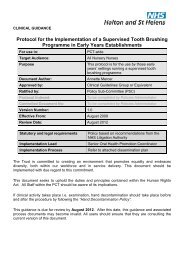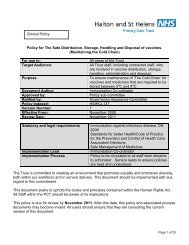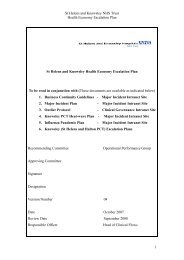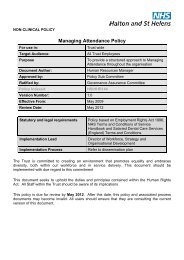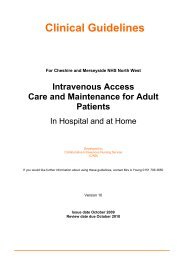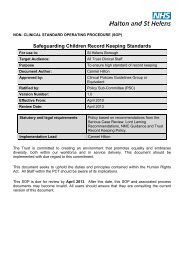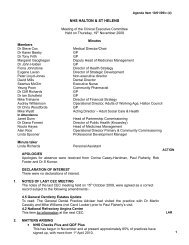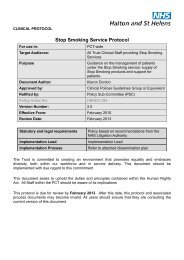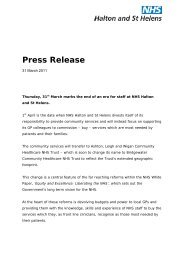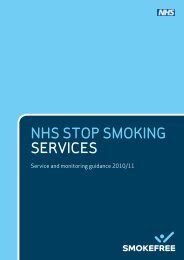Physical sensory and learning disability - Halton and St Helens PCT
Physical sensory and learning disability - Halton and St Helens PCT
Physical sensory and learning disability - Halton and St Helens PCT
Create successful ePaper yourself
Turn your PDF publications into a flip-book with our unique Google optimized e-Paper software.
<strong>Physical</strong>, <strong>sensory</strong> <strong>and</strong> <strong>learning</strong> <strong>disability</strong>IntroductionThe Disability Discrimination Act (DDA) 1995 defines a disabled person as someonewho has a physical or mental impairment that has a substantial <strong>and</strong> long-term adverseeffect on his or her ability to carry out normal day-to-day activities.It is recognized that <strong>disability</strong> can impact on individuals by: reducing their quality <strong>and</strong>length of life; restricting access to public services; <strong>and</strong> make them vulnerable to abuse.This chapter will analyse the needs of adults with physical <strong>and</strong> <strong>sensory</strong> disabilities, <strong>and</strong><strong>learning</strong> disabilities – mental health is covered in a separate chapter.Other relevant chapters:Mental HealthVulnerable AdultsOlder PeopleSocial careEconomicHousingKey issues <strong>and</strong> gaps<strong>Halton</strong> has a aging population of people with <strong>learning</strong> disabilities known toservices – 20% are aged 56+Local support for people who challenge services to prevent them being sent todistant placements away from <strong>Halton</strong>.Earlier identification <strong>and</strong> planning with older families not known to services thatmay require support in response to changing family circumstances.Adults with <strong>learning</strong> disabilities generally suffer poorer physical health than thegeneral population, experience health inequalities through difficulties in accessinggeneric healthcare <strong>and</strong> screening programmes <strong>and</strong> have a shorter life expectancy.In <strong>Halton</strong> 3.7% of adults with <strong>learning</strong> disabilities are in employment. Nationally thefigure is 6.8% <strong>and</strong> regionally 5.2%.Nationally, 50-55% of people with <strong>learning</strong> disabilities live in the family home. In<strong>Halton</strong> the figure is 47%.Addressing the complex needs of young people with profound <strong>learning</strong> <strong>and</strong>physical disabilities transferring to adult services.1
<strong>Physical</strong>, <strong>sensory</strong> <strong>and</strong> <strong>learning</strong> <strong>disability</strong>Level of need in the population<strong>Physical</strong> <strong>and</strong> Sensory <strong>disability</strong>The term ‘<strong>Physical</strong> Impairment’ refers to people who have one or more physicalimpairments. These impairments may be congenital or acquired at any age, betemporary, long-term, or fluctuating. People with physical impairments may often haveunique & multi-dimensional requirements. They therefore require tailored services toaddress them all in a person-centred holistic fashionThe term ‘Sensory Impairment’ encompasses visual impairment (including blind <strong>and</strong>partially sighted), hearing impairment (including those who are profoundly deaf,deafened <strong>and</strong> hard of hearing) <strong>and</strong> dual <strong>sensory</strong> impairment (deafblindness). Sensoryimpairments may, like physical impairments, be congenital or acquired at any age.They are more prevalent with age as are additional <strong>sensory</strong> or other impairments. Most<strong>sensory</strong> impairments develop gradually <strong>and</strong> are often secondary to other disabilities.Map 1: <strong>Halton</strong> Client Density: <strong>Physical</strong> <strong>and</strong> Sensory <strong>disability</strong>Source: Carefirst Database (31/03/09 – 01/04/10)The above map (map 1) highlights the location of clients with physical <strong>and</strong> <strong>sensory</strong><strong>disability</strong>, with the different quantities represented by the colours – The wards markedin red have the highest number of clients, whereas the darker green wards have lowernumbers.The table 1 shows that an estimated 5,968 people between the ages of 18 <strong>and</strong> 64have a physical <strong>disability</strong>. The majority of these (67%) are aged between 45 <strong>and</strong> 643
<strong>Physical</strong>, <strong>sensory</strong> <strong>and</strong> <strong>learning</strong> <strong>disability</strong>with 26% aged between 25 <strong>and</strong> 44 <strong>and</strong> 7% between 16 <strong>and</strong> 24.Table 1: People aged 18-64 predicted to have a moderate or serious physical<strong>disability</strong>, by age, projected to 20302010 2015 2020 2025 2030People aged 18-24 predicted to have a moderatephysical <strong>disability</strong>People aged 25-34 predicted to have a moderatephysical <strong>disability</strong>529 465 427 436 480667 736 732 671 630People aged 35-44 predicted to have a moderatephysical <strong>disability</strong>People aged 45-54 predicted to have a moderatephysical <strong>disability</strong>People aged 55-64 predicted to have a moderatephysical <strong>disability</strong>1190 1051 1051 1182 11902108 2108 1947 1723 17363270 3167 3312 3333 3084Total population aged 18-64 predicted tohave a moderate physical <strong>disability</strong>7764 7527 7469 7345 7120Source: PANSI, 2010Table 2 shows that 3,117 people between the ages of 18 <strong>and</strong> 64 have a <strong>sensory</strong><strong>disability</strong>. The majority of these (89%) are aged between 45 <strong>and</strong> 64 with 10% agedbetween 25 <strong>and</strong> 44 <strong>and</strong> only 1% between 16 <strong>and</strong> 24.Table 2: People predicted to have a moderate or serious <strong>sensory</strong> <strong>disability</strong>, byage, projected to 20302010 2015 2020 2025 2030People aged 18-24 predicted to have a moderateor severe <strong>sensory</strong> impairmentPeople aged 25-34 predicted to have a moderateor severe <strong>sensory</strong> impairmentPeople aged 35-44 predicted to have a moderateor severe <strong>sensory</strong> impairmentPeople aged 45-54 predicted to have a moderateor severe <strong>sensory</strong> impairmentPeople aged 55-64 predicted to have a moderateor severe <strong>sensory</strong> impairmentPeople aged 65-74 predicted to have a moderateor severe visual impairment23 21 19 19 2079 86 86 79 74251 221 219 243 244958 951 882 782 7961,806 1,746 1,800 1,831 1,6862,392 2,938 3,280 3,244 3,4144
<strong>Physical</strong>, <strong>sensory</strong> <strong>and</strong> <strong>learning</strong> <strong>disability</strong>People aged 75 <strong>and</strong> over predicted to have amoderate or severe visual impairment6,016 6,581 7,725 9,575 11,077Total population aged 18+ predicted tohave a moderate or severe hearingimpairment11,525 12,544 14,011 15,773 17,311Source: PANSI <strong>and</strong> POPPI, 2010Learning <strong>disability</strong>The current HM Government definition of ‘Learning Disability’ is set out in ValuingPeople, the 2001 White Paper on the health <strong>and</strong> social care of people with <strong>learning</strong>disabilities, included the following definition of <strong>learning</strong> disabilities.‘Learning <strong>disability</strong> includes the presence of:• a significantly reduced ability to underst<strong>and</strong> new or complex information, to learnnew skills (impaired intelligence), with;• a reduced ability to cope independently (impaired social functioning);• which started before adulthood, with a lasting effect on development.’The Public Health Observatory for Learning Disabilities [Improving Health <strong>and</strong> Lives:Learning Disabilities Observatory] is reviewing, with the Department of Health (DH)<strong>and</strong> the new Confidential Inquiry into premature deaths of people with <strong>learning</strong>disabilities (CIPOLD), this definition <strong>and</strong> has published a document outlining a workingdefinition (http://www.improvinghealth<strong>and</strong>lives.org.uk/uploads/doc/vid_7446_2010-01WorkingDefinition.pdf).Adults with <strong>learning</strong> disabilities are one of the most vulnerable groups in society,experiencing health inequalities, social exclusion <strong>and</strong> stigmatisation. In general, adultswith <strong>learning</strong> disabilities have greater <strong>and</strong> more complex health needs than the generalpopulation, <strong>and</strong> often these needs are not identified or treated. The Quality <strong>and</strong>Outcomes Framework (QOF) includes a register of patients with a <strong>learning</strong> <strong>disability</strong>,which included 665 for <strong>Halton</strong> as at 1 st January 2010.Life expectancy of this group is shorter than the general population, though this hasincreased recently. In addition a number of national reports have highlighted thatadults with <strong>learning</strong> disabilities often experience barriers to accessing healthcareservices, <strong>and</strong> poor levels of care. Indeed, adults with <strong>learning</strong> disabilities are morelikely to die from a preventable cause than the general population.Patterns of health needs amongst adults with a <strong>learning</strong> <strong>disability</strong> are different to thegeneral population, <strong>and</strong> therefore current programmes that target health inequalitiesmay exclude this population group.5
<strong>Physical</strong>, <strong>sensory</strong> <strong>and</strong> <strong>learning</strong> <strong>disability</strong>Map 2: <strong>Halton</strong> Client Density: Clients with Learning DisabilitiesSource: Carefirst Database (31/03/09 – 01/04/10)Map 2 highlights the location of clients with <strong>learning</strong> disabilities, with the differentquantities represented by the colours – The wards marked in red have the highestnumber of clients, whereas the darker green wards have lower numbers.Nationally the numbers of adults with a <strong>learning</strong> <strong>disability</strong> is rising, <strong>and</strong> for the olderpopulation (65+) an 11% increase is predicted for those aged between 65-84 <strong>and</strong> a14% increase for those aged 85+ in the period to 2015. In <strong>Halton</strong>, the number ofadults with a <strong>learning</strong> <strong>disability</strong> is also rising, but at a steadier rate.Table 3: People predicted to have a <strong>learning</strong> <strong>disability</strong>, by age2010 2015 2020 2025 2030People aged 18-24 predicted to have a <strong>learning</strong><strong>disability</strong>People aged 25-34 predicted to have a <strong>learning</strong><strong>disability</strong>People aged 35-44 predicted to have a <strong>learning</strong><strong>disability</strong>People aged 45-54 predicted to have a <strong>learning</strong><strong>disability</strong>293 257 235 239 263361 398 396 364 341399 354 355 400 404395 397 369 328 3326
<strong>Physical</strong>, <strong>sensory</strong> <strong>and</strong> <strong>learning</strong> <strong>disability</strong>People aged 55-64 predicted to have a <strong>learning</strong><strong>disability</strong>358 347 364 366 339People aged 65-74 predicted to have a <strong>learning</strong><strong>disability</strong>209 255 289 286 301People aged 75-84 predicted to have a <strong>learning</strong><strong>disability</strong>116 124 139 179 201People aged 85 <strong>and</strong> over predicted to have a<strong>learning</strong> <strong>disability</strong>34 40 48 60 75Total population aged 18 <strong>and</strong> overpredicted to have a <strong>learning</strong> <strong>disability</strong>2,165 2,173 2,194 2,223 2,255Source: PANSI/POPPI, 2010Adults with <strong>learning</strong> disabilities in settled accommodation (NI 145 <strong>and</strong>Vital Sign VSC05)The percentage of adults with <strong>learning</strong> disabilities living in settled accommodation in<strong>Halton</strong> is 86.7%. This is a significantly higher figure than either the regional (66.1%) ornational average (64.5%)Figure 1: Adults with <strong>learning</strong> disabilities in settled accommodationAdults with <strong>learning</strong> disabilities in settled accommodation - NI 145100.090.080.070.0% of Adults60.050.040.030.020.010.0<strong>Halton</strong>NWEngl<strong>and</strong>0.02008/09Source: Places Analysis Tool, NI 145 (2008/09)7
<strong>Physical</strong>, <strong>sensory</strong> <strong>and</strong> <strong>learning</strong> <strong>disability</strong>Adults with <strong>learning</strong> disabilities in employment (NI 146 <strong>and</strong> Vital SignVSC07)The percentage of adults with <strong>learning</strong> disabilities in employment within <strong>Halton</strong> is 3.7%.This is lower than the regional average (5.2%) <strong>and</strong> considerably lower than theaverage national rate (6.8%)Figure 2: Adults with <strong>learning</strong> disabilities in empolymentAdults with <strong>learning</strong> disabilities in employment - NI 1468.07.06.0% of Adults5.04.03.0<strong>Halton</strong>NWEngl<strong>and</strong>2.01.00.02008/09Source: Places Analysis Tool, NI 146 (2008/09)Current services in relation to need<strong>Physical</strong> DisabilityCare management <strong>and</strong> assessment services.This service works with disabled people, their carers <strong>and</strong> families to assess need <strong>and</strong>develop appropriate support to maximise independence. Separate teams areestablished for physically <strong>and</strong> <strong>sensory</strong> disabled people <strong>and</strong> those with <strong>learning</strong>disabilities.Located within assessment <strong>and</strong> care management services is the Visual ImpairmentRehabilitation Service offering individual assessments of need across all ages, takingfull account of any remaining vision <strong>and</strong> the impact of dual <strong>sensory</strong> loss. Identifiedpsychological <strong>and</strong> emotional needs associated with loss of vision are addressedthrough counselling <strong>and</strong> implementation of rehabilitation training programs. Anyindentified specialist communication needs (British Sign Language) or equipmentspecific for the individuals hearing loss are referred on to the specialist Deafblind8
service.<strong>Physical</strong>, <strong>sensory</strong> <strong>and</strong> <strong>learning</strong> <strong>disability</strong><strong>Halton</strong> Home Improvement <strong>and</strong> Independent Living Services (HHIILS)<strong>St</strong>rategies promoting independence <strong>and</strong> enabling people to continue to live in thecommunity have led to a national increase in dem<strong>and</strong> for home adaptations,equipment, housing support <strong>and</strong> preventative services to enable people to live athome.The HHIILS team is responsible for assessing the long-term needs of children, adults<strong>and</strong> older people, resident in <strong>Halton</strong>, who have a permanent <strong>and</strong> substantial <strong>disability</strong><strong>and</strong> providing permanent adaptations to their homes.<strong>Halton</strong> has reconfigured its Home Improvement <strong>and</strong> Independent Living service toimprove the response to Older <strong>and</strong> Disabled people through a partnership approachwith local registered social l<strong>and</strong>lords to substantially increase the number ofadaptations within social rented stock <strong>and</strong> develop an Accessible Homes Register toprioritise disabled people when such properties are vacated.Day ActivitiesIn <strong>Halton</strong> day services have moved from the traditional large day centre to communitybased satellite centres offering meaningful activity <strong>and</strong> or <strong>learning</strong> <strong>and</strong> employmentopportunities.For many of those who access such support, this change has demonstrably increasedtheir confidence so they are now in a position to take full advantage of thePersonalisation Agenda <strong>and</strong> exercise greater choice in how they spend their time <strong>and</strong>with whom.Using community facilities has identified issues of accessibility. Longer-term, anyimprovements in the accessible environment as a result of this initiative will bringbenefits to the wider community.Independent Living CentreThis facility is able to offer disabled people <strong>and</strong> carers advice on <strong>and</strong> the opportunity totry out equipment that will assist with independent living. Vision Support also has itsresource centre based here.Services provided by the third sectorHearing Impairment Services – Deafness Resource CentreDeafness Resource Centre is commissioned by the Council from April 2011 to offer specialist knowledge <strong>and</strong> communication skills to assess need of children<strong>and</strong> adults who are deaf or hearing impaired <strong>and</strong> their carers. Technical assessments for suitability of environmental equipment . Information in a range of formats on available support <strong>and</strong> signposting to otherservices as appropriate.Work is ongoing to raise community awareness of the issues faced by deaf children<strong>and</strong> adults <strong>and</strong> to further develop early intervention <strong>and</strong> preventative support .9
<strong>Physical</strong>, <strong>sensory</strong> <strong>and</strong> <strong>learning</strong> <strong>disability</strong>Visual impairment services - Vision SupportVision Support is commissioned by <strong>Halton</strong> Borough Council <strong>and</strong> NHS <strong>Halton</strong> <strong>and</strong> <strong>St</strong><strong>Helens</strong> to provide a range of services to adults <strong>and</strong> older people with visual impairmentincluding:Access to a Resource Centre offering information, advice <strong>and</strong> small items ofequipment for purchase to help with daily living <strong>and</strong> improve their quality of life.Support Workers who visit people in their own home to demonstrate equipment<strong>and</strong> assist with daily living tasks.IT Training in the use of speech <strong>and</strong> magnification software <strong>and</strong> advice is givenon the availability of free software that can be downloaded at home.Telephone befriending through volunteers to maintain contact <strong>and</strong> relieve socialisolation.User Led Organisation – <strong>Halton</strong> Disability Partnership<strong>Halton</strong> Disability Partnership is a small local voluntary organisation, which aims to raiseawareness of the needs <strong>and</strong> wishes of people with disabilities <strong>and</strong> to help provideinformation <strong>and</strong> support to enable them to live independently.Learning DisabilitySafeguardingThe vision of <strong>Halton</strong>’s Safeguarding Adults Board is of a <strong>Halton</strong> where vulnerablepeople are safe from abuse <strong>and</strong> harm, whilst being empowered to make their ownchoices <strong>and</strong> to choose risks. This resonates with <strong>Halton</strong>’s vision for people with<strong>learning</strong> disabilities of supporting them to achieve greater independence whilstensuring safeguards are in place to protect people from <strong>and</strong> prevent abuse.Model of careThe model is being reviewed to respond to the move away from specialist inpatientsupport to community focussed services <strong>and</strong> is based on the premise that all peoplewith <strong>learning</strong> disabilities can lead fulfilling lives in the community supported by‘ordinary’ <strong>learning</strong> <strong>disability</strong> services. They will sometimes have physical or mentalhealth problems <strong>and</strong> should be supported to access mainstream health services.Where they need more specialist support, including needs arising from challengingbehaviour, they will have access to skilled support staff <strong>and</strong> where necessary specialistprofessionals to assist assessment <strong>and</strong> help plan more effective support.HealthcareAll adults with a <strong>learning</strong> <strong>disability</strong> known to social care are being offered an annualhealth check <strong>and</strong> opportunity to develop a health action plan. Health passports havebeen introduced to aid hospital staff in underst<strong>and</strong>ing the individual e.g. aroundcommunication <strong>and</strong> improve the patient experience.Learning Disability Nurses are located in the integrated Care Management <strong>and</strong>Assessment Team. This team also acts as the gatekeeper to a range of specialist,community based support such as occupational <strong>and</strong> speech <strong>and</strong> language therapists.Short stay, in-patient, assessment <strong>and</strong> treatment interventions for people with <strong>learning</strong>disabilities <strong>and</strong> associated challenging behaviour or mental health issues are availableat Hollins Park.10
<strong>Physical</strong>, <strong>sensory</strong> <strong>and</strong> <strong>learning</strong> <strong>disability</strong>Positive Behaviour ServiceThis specialist service, skilled in behavioural approaches, supports frontline servicesworking with adults <strong>and</strong> children with <strong>learning</strong> disabilities whose behaviour challenges.The aim is to improve outcomes for individuals <strong>and</strong> their families, <strong>and</strong> to support costeffective<strong>and</strong> local responses for people with complex needs, including autism.Support for CarersA number of actions have been targeted at older families, including completing aperson centred plan with the cared for <strong>and</strong> working with families to establish contacts<strong>and</strong> arrangements for the Community Learning Disability Team to act on should anemergency situation arise.<strong>Halton</strong> Carers Centre is actively working to identify hidden carers <strong>and</strong> encourage selfassessment of low level need <strong>and</strong> signposting to available support.Short Breaks<strong>Halton</strong> recognises the pressures placed on family members caring for a person with<strong>learning</strong> disabilities <strong>and</strong> offers opportunities for breaks from caring. For <strong>learning</strong>disabled adults with accompanying complex physical needs, residential respite supportis available at Bredon. A significant number of carers opt for direct payments to givethem full flexibility around when <strong>and</strong> how they receive support.Developing the Provider MarketIn 2010 the Council is positioning the provider market to move away from traditionalblock contracts for supported living services <strong>and</strong> encouraging more personalised,flexible <strong>and</strong> innovative support whether a person is purchasing this for themselves or itis commissioned on their behalf.EmploymentIn <strong>Halton</strong> the number of people with <strong>learning</strong> <strong>disability</strong> in employment at 3.7% is lowerthan both the National figure for Engl<strong>and</strong> (7.5%) <strong>and</strong> Comparator Authority figure(4.1%). The Enterprise <strong>and</strong> Employment Division within the Council takes the lead onemployment for disabled people. Health <strong>and</strong> Social Care have an active role inpromoting employability amongst people with <strong>learning</strong> disabilities <strong>and</strong> their familiesparticularly targeting young people in Year 9 (age 14+) to raise their aspirations beforeleaving school <strong>and</strong> moving into adult services.<strong>Halton</strong>’s daytime <strong>and</strong> community support service continues to extend the number ofopportunities for people to train for, experience <strong>and</strong> gain employment, whilst theCommunity Bridge Builder Service is supporting people into paid or voluntary work.Services provided by the third sector<strong>Halton</strong> Speak Out support adults with <strong>learning</strong> disabilities in voicing their views toinfluence improvements in local services. They also co-ordinate Person CenteredPlanning in <strong>Halton</strong>.11
<strong>Physical</strong>, <strong>sensory</strong> <strong>and</strong> <strong>learning</strong> <strong>disability</strong>Evidence of what worksOur Health, Our Care Our Say (Department of Health, 2006) this white paper sets thevision for Health <strong>and</strong> Social Care services by setting four goals to be achieved: Better prevention <strong>and</strong> early intervention for improved health, independence <strong>and</strong>well-being More choice <strong>and</strong> a stronger voice for local individuals <strong>and</strong> communities Tackling inequalities <strong>and</strong> access to community based services More support for people with long term needs.High Quality Care For All (Department of Health, 2008) this report written by LordDarzi builds on the goals of the white paper <strong>and</strong> further highlights the need to improvepreventative services, deliver more health services locally <strong>and</strong> improve choicesavailable to people.Putting People First (Department of Health, 2007) the national concordat, set out thevision, aims <strong>and</strong> values that will guide the Transformation of Adult Social Care. Itsupports the need for universal access to low level preventative services that includeequipment <strong>and</strong> other home support services.National Service Framework (NSF) for Long Term Conditions (Department ofHealth, 2005) was published to raise st<strong>and</strong>ards for people with long-term neurologicalconditions requiring treatment to access to care <strong>and</strong> support across Health <strong>and</strong> SocialCare Services. Whilst the NSF is focussed on people with long term neurologicalconditions the principles underpinning the framework apply to all physically disabledpeople.The Social Policy Research Unit 1 have published a research paper identifying threetypes of service that promote continuity of care for people with long term neurologicalconditions: Community based inter-disciplinary neuro-rehabilitation teams Nurse Specialists Proactive holistic day opportunities.Prevention <strong>and</strong> early intervention (P&EI) Health <strong>and</strong> social care have developed ajoint strategy for P&EI in <strong>Halton</strong> aimed at promoting the independence of older peoplebut also transferring the <strong>learning</strong> to other disabled people. Emphasis is placed ontelecare <strong>and</strong> telehealth to support self management of long term conditions <strong>and</strong>enabling people to remain independent to avoid unplanned hospital admissions.Improving the Life Chances of Disabled People (2005)A further cross government policy to transform the life choices of disabled people sothat by 2025 they have full opportunities <strong>and</strong> choices to improve their quality of life <strong>and</strong>be respected <strong>and</strong> included as full members of society.1 Bernard S., Aspinal ., Grindley K., Parker G (20101) Integrated Services for people withLong Term Neurological Conditions: evaluation of the impact of the NSF, Research Works2010-05, Social Policy Research Unit, University of York, York.12
<strong>Physical</strong>, <strong>sensory</strong> <strong>and</strong> <strong>learning</strong> <strong>disability</strong>Key contacts <strong>and</strong> further linkshttp://www.improvinghealth<strong>and</strong>lives.org.uk/ – Improving Health <strong>and</strong> Lives: LearningDisability Observatory.http://www.valuingpeoplenow.dh.gov.uk15




